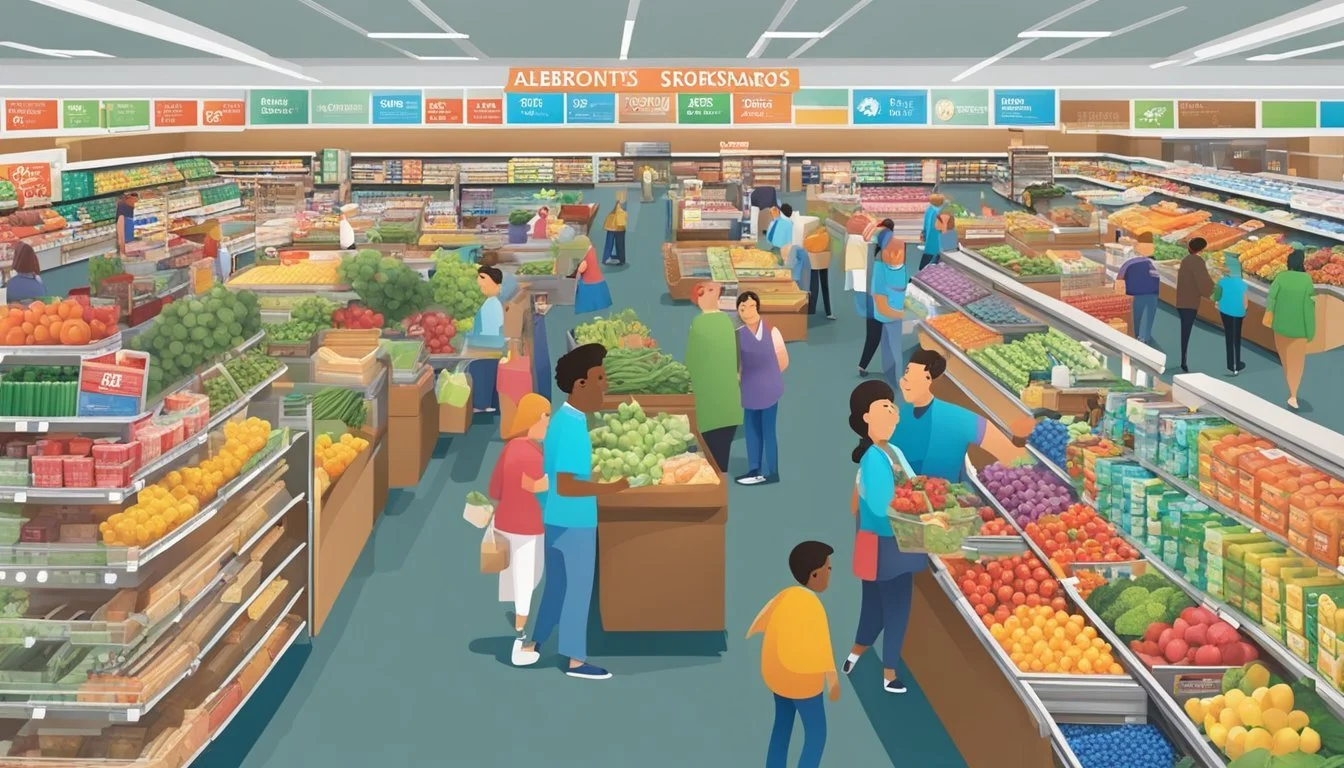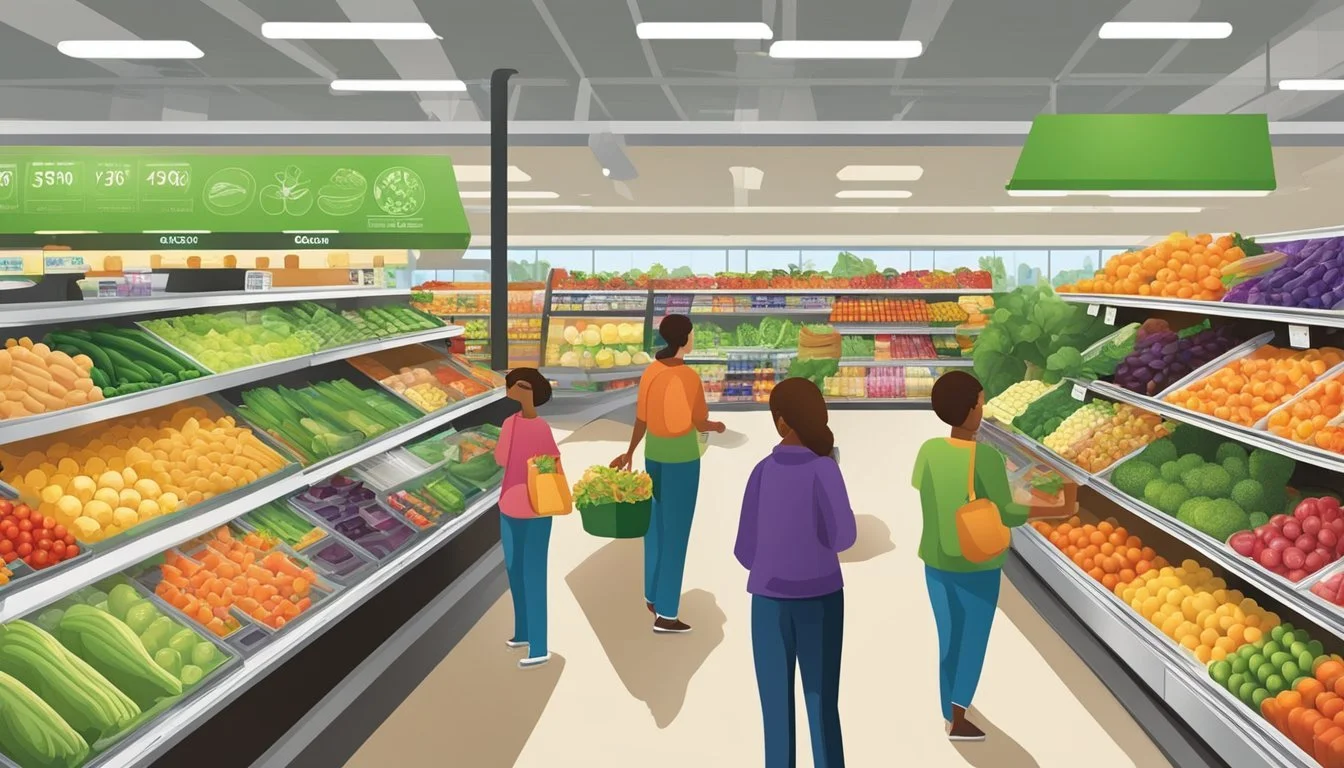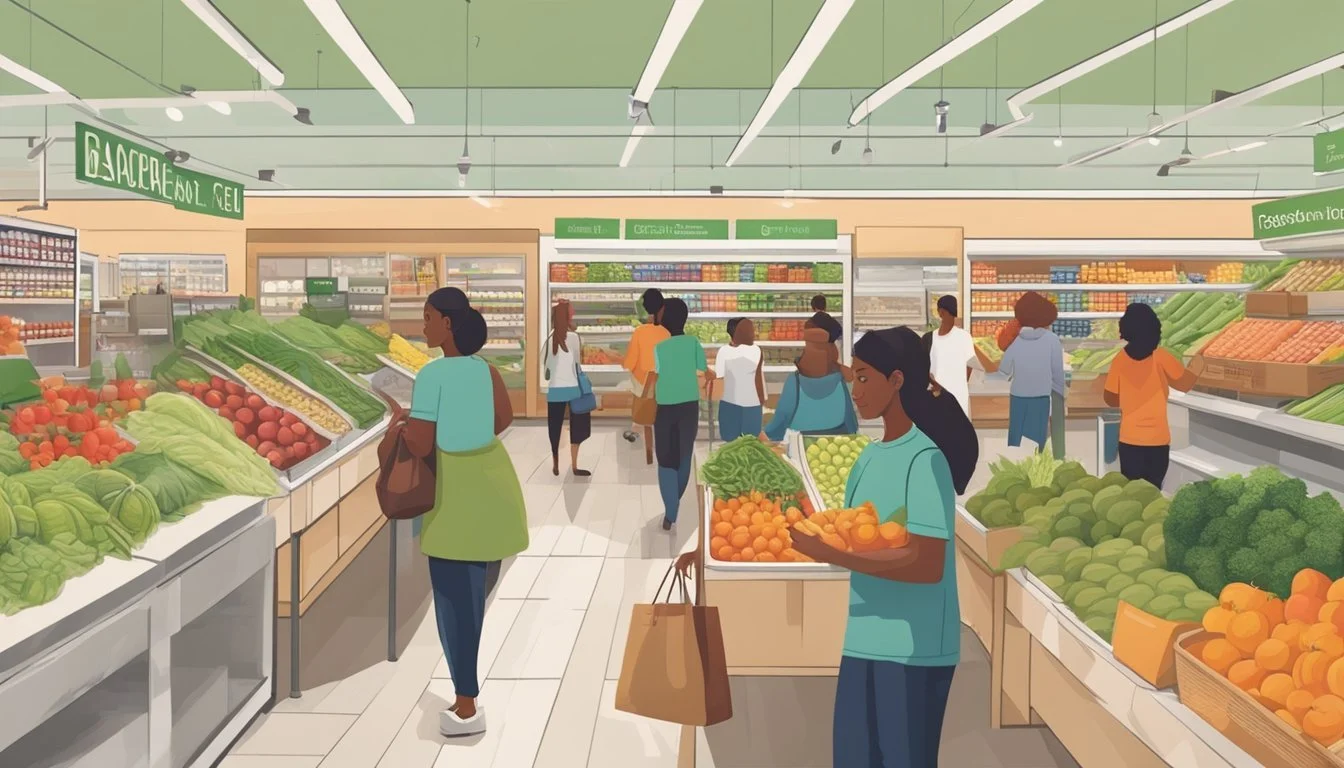Albertsons vs Lucky Supermarkets
A Comprehensive Comparison of Prices, Selection, and Service
Albertsons and Lucky Supermarkets are two prominent grocery store chains that offer a range of products and services to shoppers across the United States. Both stores aim to provide quality food items, competitive prices, and convenient shopping experiences for their customers.
Albertsons, founded in 1939, has grown into one of the largest food and drug retailers in the country. The company operates over 2,200 stores under various banners, including Albertsons, Safeway, and Vons. Albertsons is known for its fresh produce, quality meats, and popular store-brand products, which often provide good value for shoppers.
Lucky Supermarkets, on the other hand, has a smaller footprint but maintains a loyal customer base in certain regions. The chain focuses on offering competitive prices and a diverse selection of products to cater to different customer preferences. Lucky stores often feature well-stocked ethnic food sections and local produce, appealing to diverse communities.
Company Overview
Albertsons and Lucky Supermarkets are two prominent grocery chains in the United States. Both have rich histories and have undergone significant changes over the years.
History of Albertsons
Albertsons was founded in 1939 by Joe Albertson in Boise, Idaho. The company grew rapidly, expanding across the western United States. In 1999, Albertsons acquired American Stores Company, which owned Lucky Supermarkets.
By 2006, Albertsons had become one of the largest grocery retailers in the country. The company faced financial challenges and was split into multiple parts. Supervalu acquired a significant portion of Albertsons' operations.
In 2013, Albertsons merged with Safeway, creating a network of over 2,200 stores. This merger solidified Albertsons' position as the second-largest supermarket chain in North America after Kroger.
History of Lucky Supermarkets
Lucky Stores was established in 1935 in San Leandro, California. The chain quickly became a popular grocery destination in Northern California. Lucky expanded its presence throughout the state and into other regions.
In 1998, American Stores Company, Lucky's parent company, was acquired by Albertsons. This acquisition led to the disappearance of the Lucky brand by 1999.
In 2006, the Lucky name resurfaced when Grocery Outlet briefly used it for a store in Rocklin, California. However, Supervalu, which had acquired part of Albertsons, began reopening Lucky-branded stores in Southern California and Nevada.
Today, Lucky Supermarkets operate under different ownership in different regions. Albertsons runs Lucky stores in Utah, while Save Mart Supermarkets operates them in Northern California.
Store Locations and Presence
Albertsons and Lucky Supermarkets have distinct regional footprints. Albertsons operates stores across multiple states, while Lucky focuses primarily on Northern California.
Albertsons Regional Stores
Albertsons maintains a strong presence in several Western and Southern states. The chain operates numerous locations in California, including stores in Scottsdale and other parts of the state.
Albertsons also has a significant footprint in states like Idaho, Oregon, and Washington. The company's expansion has led to stores in Utah, Nevada, and parts of the Midwest.
In Southern California, Albertsons competes with other major grocery chains. The retailer has adapted its store formats to suit different local markets and consumer preferences.
Lucky Supermarkets in the Bay Area- Local Grocery Dynamics
Lucky Supermarkets primarily serves the Bay Area in Northern California. The chain focuses on providing groceries to local communities in this region.
Lucky's history dates back to 1935 when it was founded in San Leandro, California. The brand has changed ownership over the years but maintains its Bay Area focus.
Save Mart Supermarkets currently operates Lucky stores in Northern California. This localized approach allows Lucky to tailor its offerings to Bay Area shoppers' needs.
Lucky competes with larger chains and local grocers in the competitive Bay Area market. The brand's longevity in the region has built customer loyalty among local shoppers.
Pricing and Value
Albertsons and Lucky Supermarkets employ different pricing strategies to attract customers. Both stores offer ways for shoppers to save money on their grocery bills.
Comparison of Pricing Strategies
Albertsons tends to have slightly higher regular prices but offers frequent sales and promotions. They run weekly specials on various items throughout the store.
Lucky Supermarkets generally maintains lower everyday prices across most product categories. Their pricing model focuses on consistent value rather than deep discounts on select items.
For a family spending $250 per week on groceries, the price differences between these chains can add up over time. Shoppers may save 5-10% at Lucky compared to Albertsons' regular prices.
Ways to Save at Albertsons and Lucky
Albertsons provides several savings opportunities:
Just for U digital coupons
Club Card discounts
Weekly ad specials
Buy one, get one free deals
Lucky offers fewer promotions but emphasizes everyday low prices. Their savings options include:
Digital coupons through their app
Weekly ad deals
Lucky Rewards program
Both stores accept manufacturer coupons. Savvy shoppers can maximize savings by combining store and manufacturer offers when available.
Product Range and Quality
Albertsons and Lucky Supermarkets offer diverse product selections to cater to different customer preferences. Both chains strive to provide fresh produce, quality meats, and a mix of store brands and national brands.
Produce and Meat Quality
Albertsons emphasizes high-quality produce, often sourcing from local farms when possible. Their stores typically feature a wide variety of fruits and vegetables, with seasonal offerings prominently displayed.
Lucky Supermarkets also prioritizes fresh produce but may have a smaller selection compared to Albertsons. Both chains maintain dedicated butcher sections, offering various cuts of meat.
Albertsons tends to have a slight edge in meat quality, with a broader range of premium cuts and organic options. Lucky Supermarkets focuses on competitive pricing for their meat products.
Availability of Organic and Specialty Foods
Albertsons has made significant strides in expanding its organic and specialty food offerings. Many stores feature dedicated organic produce sections and aisles for health-conscious consumers.
Lucky Supermarkets provides organic options but generally has a more limited selection compared to Albertsons. Both chains stock gluten-free, vegan, and international food items, with Albertsons typically offering a wider variety.
Specialty foods like artisanal cheeses and gourmet ingredients are more readily available at Albertsons, particularly in their larger store formats.
Store Brands vs. National Brands
Albertsons offers several private label brands, including Signature Select and O Organics. These store brands cover a wide range of products, from pantry staples to frozen foods.
Lucky Supermarkets also has its own private label products, though the selection may be more limited than Albertsons. Both chains stock popular national brands across all departments.
Store brands at both supermarkets generally offer good value for money. Albertsons' private label products often receive positive reviews for quality, while Lucky's store brands focus on affordability.
National brands are well-represented in both stores, with Albertsons typically carrying a broader range of premium and niche brands.
Customer Experience
Albertsons and Lucky Supermarkets strive to provide positive shopping experiences. Key factors include store layout, cleanliness, checkout efficiency, and customer service quality. These elements significantly impact customer satisfaction and loyalty.
Store Layout and Cleanliness
Albertsons emphasizes wide aisles and logical product placement. Their stores typically feature bright lighting and clear signage. Regular cleaning schedules maintain a tidy appearance.
Lucky Supermarkets often have a more compact layout. They focus on maximizing space efficiency. While this can make navigation challenging, it allows for competitive pricing.
Both chains prioritize cleanliness, but customer reviews suggest Albertsons edges out Lucky in this area. Albertsons' larger stores may contribute to a perception of better upkeep.
Checkout Efficiency
Albertsons invests in technology to speed up checkout processes. Many locations offer self-checkout options and mobile payment systems. Their loyalty program integrates with checkout for a seamless experience.
Lucky Supermarkets maintain a more traditional approach. They rely on staffed checkouts and personal interactions. This can lead to longer wait times during peak hours.
Customer surveys indicate faster average checkout times at Albertsons. However, some shoppers prefer Lucky's personalized service.
Customer Service Comparisons
Albertsons trains staff to provide knowledgeable assistance. They emphasize product familiarity and problem-solving skills. Customer service desks are prominently located for easy access.
Lucky Supermarkets foster a community-oriented atmosphere. Staff often develop personal relationships with regular customers. This approach can lead to more individualized service.
Research shows mixed results in customer service satisfaction between the two chains. Albertsons scores higher in efficiency, while Lucky excels in personal connections.
Both stores actively seek customer feedback. They use surveys and online reviews to identify areas for improvement. This commitment to adaptation helps maintain competitive customer experiences.
Additional Services
Albertsons and Lucky Supermarkets offer various additional services to enhance the shopping experience. These include prepared food options and convenient delivery services.
Prepared Foods and Deli
Both Albertsons and Lucky Supermarkets provide extensive prepared food and deli offerings. Albertsons features a wide selection of hot and cold prepared meals, salads, and side dishes. Their deli counter offers freshly sliced meats and cheeses, as well as made-to-order sandwiches.
Lucky Supermarkets also boasts a robust deli section with rotisserie chickens, pre-made entrees, and side dishes. Their bakery department produces fresh bread, cakes, and pastries daily.
Both chains prioritize convenience for busy shoppers, offering grab-and-go meal solutions. Quality and variety may vary by location, but both stores aim to provide tasty options for quick meals.
Grocery Delivery Options
Albertsons and Lucky Supermarkets have embraced online ordering and delivery services. Albertsons offers home delivery through their website and mobile app. Customers can choose from same-day or scheduled delivery options.
Lucky Supermarkets partners with third-party delivery services like Instacart in many locations. This allows customers to order groceries online and have them delivered to their doorstep.
Both chains have implemented curbside pickup services at select stores. Customers can order online and collect their groceries without entering the store. Delivery fees and minimum order requirements may apply, varying by location and service type.
Loyalty Programs and Discounts
Albertsons and Lucky Supermarkets offer distinct rewards programs and discount opportunities to attract and retain customers. These initiatives aim to provide value and savings for shoppers.
Overview of Rewards Programs
Albertsons operates the free-to-join Just for U loyalty program. Members earn points on purchases and receive personalized deals and digital coupons.
Lucky Supermarkets provides the Lucky You rewards program. Shoppers collect points that can be redeemed for discounts on future purchases.
Both programs offer mobile apps for easy access to deals and account management. Albertsons' program tends to offer more personalized savings based on shopping history.
Comparing Discount Opportunities
Albertsons frequently runs "Mix and Match" sales, allowing customers to save when buying multiple qualifying items. They also offer digital and printable coupons through their app and website.
Lucky Supermarkets is known for its competitive everyday low prices. They feature weekly specials and digital coupons accessible through their app.
Both chains utilize loss leaders - deeply discounted popular items to draw customers in. Albertsons often has more extensive sales events, while Lucky focuses on consistent low pricing.
Savvy shoppers can maximize savings at either store by combining loyalty program discounts with manufacturer coupons and weekly specials.
Brand Perception and Market Position
Albertsons and Lucky Supermarkets occupy distinct positions in the grocery retail landscape. Consumer perceptions and market performance shape their competitive standings.
Consumer Reports Insights
Consumer Reports surveys reveal mixed feedback for Albertsons and Lucky. Albertsons receives average ratings for product quality and customer service. Lucky scores slightly higher in freshness and local product availability.
Both chains lag behind competitors like Walmart and Target in pricing perceptions. However, Albertsons edges out Lucky in store cleanliness and checkout speed ratings.
Consumer Reports research indicates that Albertsons has stronger brand recognition nationally. Lucky maintains a loyal following in its regional markets, particularly in Northern California.
Market Performance and Trends
Albertsons holds a larger market share, ranking as the fourth-largest grocery chain in the U.S. The company's 2022 merger with Kroger aims to boost its competitive position against Walmart and Target.
Lucky Stores, now operated by Save Mart in Northern California, has a more limited footprint. Its market performance focuses on regional dominance rather than national expansion.
Both chains face increasing pressure from e-commerce and discount retailers. Albertsons has invested heavily in digital platforms and delivery services. Lucky emphasizes its local roots and community connections to maintain customer loyalty.
Sustainability and Community Engagement
Albertsons and Lucky Supermarkets prioritize sustainability and community involvement through various initiatives. Both chains focus on environmental stewardship and supporting local communities.
Environmental Initiatives
Albertsons has implemented a comprehensive sustainability program called "Recipe for Change." This initiative aims to reduce the company's environmental footprint across its operations. Albertsons has set goals to decrease greenhouse gas emissions, minimize food waste, and increase the use of recyclable packaging.
Lucky Supermarkets, as part of The Save Mart Companies, also emphasizes eco-friendly practices. They have introduced energy-efficient lighting and refrigeration systems in their stores. Lucky also encourages customers to use reusable bags and offers recycling programs for plastic bags and containers.
Support for Local Producers and Charities
Albertsons actively partners with local farmers and producers to stock their shelves with fresh, regional products. This approach supports local economies and reduces transportation-related emissions. The company also operates the Albertsons Companies Foundation, which provides grants to nonprofit organizations focused on hunger relief, education, and health initiatives.
Lucky Supermarkets takes pride in its community involvement. They collaborate with local food banks and charities to address food insecurity. Lucky also sponsors youth sports teams and school programs in the areas they serve. By sourcing products from nearby farms, Lucky supports local agriculture and offers customers fresher produce options.










